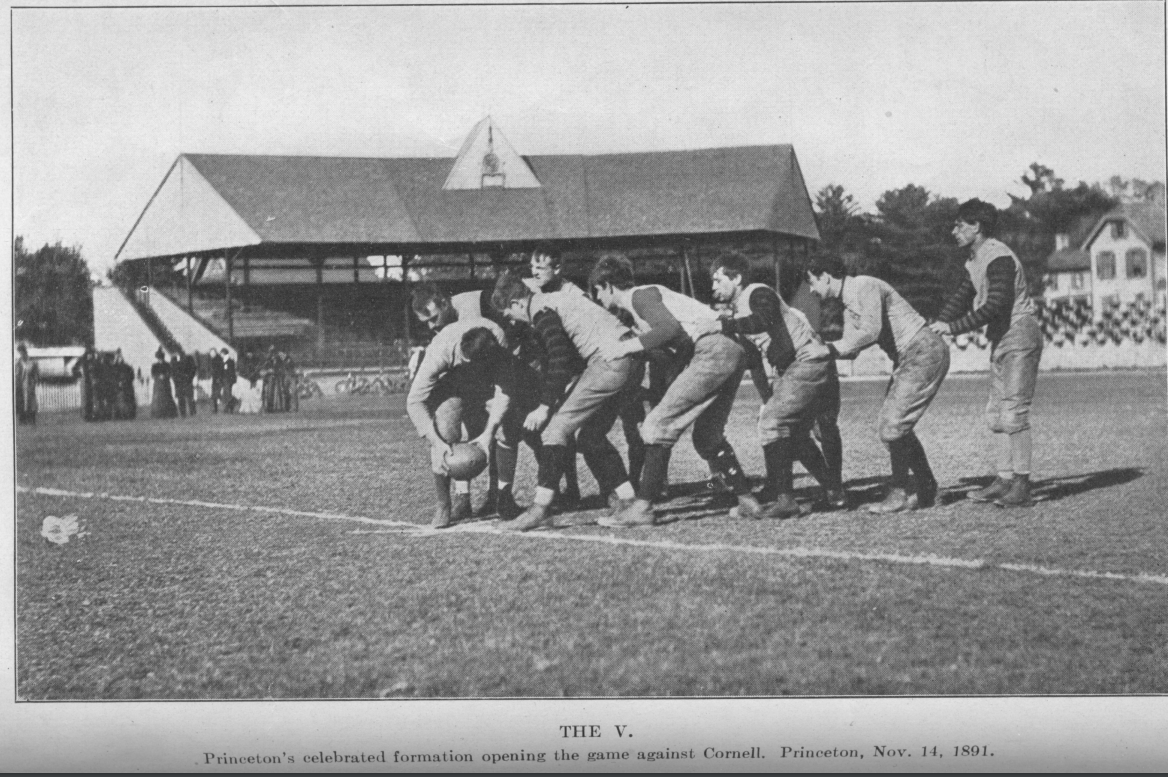In this edition of the Football History Rewind we discuss an offensive formation established by Princeton that devastated opponents and almost the game itself.
Football 1891 & 1892
Football 1891 and 1892
The “V” Formation Wreaks Havoc
Football in 1890 had its problems in rules particularly dealing with who was eligible to play the games at the collegiate level but it also was spreading like a wildfire across the country. The controversy over player eligibility split the American Intercollegiate Football Association as Harvard withdrew from the group and Yale though still an active member was scheduling independent games against Harvard.
1891… a quiet year
Administrators of the Intercollegiate Football Association had to be breathing a sigh of relief in 1891 as there were no real changes in rules or any dramatic impending controversies to deal with in the realm of football. The state of the game was an exact carbon copy of the previous year; it was as if no one knew what to do to improve the situations so instead they tiptoed around them for another year.
One big highlight from the 1891 season in strategy was that the “V –formation” of Princeton was dominating those who opposed it. This latest version of the “V”
Had players who were very comfortable with its style, and they knew exactly what to do in the formation. (Please see the photograph for a good look at the “V-formation.”)

A depiction of Princeton's famous V-Formation in 1891 against Cornell on November 14, 1891 from Parke H. Davis' book Football the Intercollegiate Game.
The following year would not be so quiet though on the rules front. Football would move on with changes.
Session of Graduate Advisory Committee: 21 March, 1892
The Committee was back and they had thought of some rule changes to recommend during their hiatus. The suggestions for change by the group totaled three from this session:
If the ball was fumbled on a “punt-out” it would be re-kicked. Should it be fumbled a second time the opponents would start a possession at the center of the field.
If a “bona-fide” attempt at goal is tried and missed, the ball will go to the opponents at the center of the field.
Any person who is not a player that attempts to “coach” will be warned and a second offense will be removed from the field enclosure.
These changes could have a big impact on the style of play at the time as punt-outs and kicks for goal were quite common. The Committee was recommending a penalty of sorts for those who tried kicks and missed. It would make teams think twice about taking half baked attempts as there are now may be consequences to a miss. These were merely suggestions at this point in time though, as the Association would again call a convention for members to vote on the recommendations and pass before they could become rules.
Convention of 12 May, 1892
Actually all three recommendations of the Graduate Advisory Committee were accepted after some slight modifications. The wording was changed to make them a bit more concise and pertinent.
Rule 34 read, “If a punt-out from a touchdown is missed or is not fairly caught, the ball shall be taken to the centre of the field and given to the defenders of that goal.”
Rule 32 was added and stated, “If the try for goal following a touchdown be missed the ball shall be brought to the centre of the field and be given to the defenders of that goal.”
Another new rule stated, “The Umpire shall warn any person coaching from the sidelines. Upon a second offense the person shall be ordered behind the ropes or fence.”
As an official in today’s era we are probably all asking ourselves if this third rule revision from 1892 could be reinstated to our rules. It seems as though coaching could only be done during games from the on-field captains. There were no coaches per as the captains were in charge of the teams.
Strategy achievements in 1892
Most schools had adopted Princeton’s V-formation into their own playbooks because of its effectiveness. Harvard however tweaked it just a bit to add a bit of a surprise against rival Yale in their November match in 1892. Yale opened the first half running the Princeton V also known as the V-trick. Harvard settled into the common defense of the formation making their own V shaped formation. The start of the second half had Harvard springing their surprise on the Yale squad. Yale expecting the V to again appear, as was common by all teams of that era to start a period, was awed when the Harvard forwards ran to the 55 yard-line (yes this does say 55 yard –line). One lone Harvard player, B.W. Trafford remained in the center of the field holding the ball at the center of Harvard’s 45 yard-line as the remaining ten players for the Crimson then retreated to their own 25 yard-line as they divided into two groups of five players each. Each group gathered near each sideline. This all occurred before the ball was put into play. Trafford after a short pause would wave his arm, without putting the ball in play, and this signaled the two groups locked together to come swiftly forward towards Trafford with tremendous momentum. The Yale players looked on as Trafford disappeared in the mass of humanity. It was almost at the last moment when Yale realized what was happening and they started pulling the formation apart finally tackling Trafford at their own 25 yard-line.
The formation Harvard’s Lorin F. Deland had devised would forever be known as the “Flying Wedge.” Yale was ready for the challenge though, as Walter Camp received some intel on the formation and devised a way to stop it. Stop Yale did as they wone the tightly fought contest with Harvard 6-0. The 1892 Yale Bulldogs football teamcompiled a perfect 13–0 record, outscored opponents by a total of 429 to 0, and has been recognized as the national champion by the Billingsley Report, Helms Athletic Foundation, Houlgate System, National Championship Foundation, and Parke H. Davis according to Wikipedia.
The game was being taken to a whole new level of strategy and ingenuity with formations such as this. It was these strategies that helped shape the game and the rules that governed it. More details of the changes can be seen in our next edition of this football history timeline coming soon on the Dispatch. Right here on PigskinDispatch.com, your place for the good news about football.

A depiction of Harvard's Flying Wedge in 1892 against Yale on November 19, 1892 from Parke H. Davis' book Football the Intercollegiate Game.
We are able to give this in depth look from so long ago in history by careful research. Using someone who was contemporary to the period is the best source. So a very special shout out to our main source of reference information for this article is from Parke H. Davis in his 1911 book Football-The American Intercollegiate Game.
Photo Credits
The pictures above are from the Wikimedia Commons' collection and is a photos some 1884 teams taken by unknown photographers.






